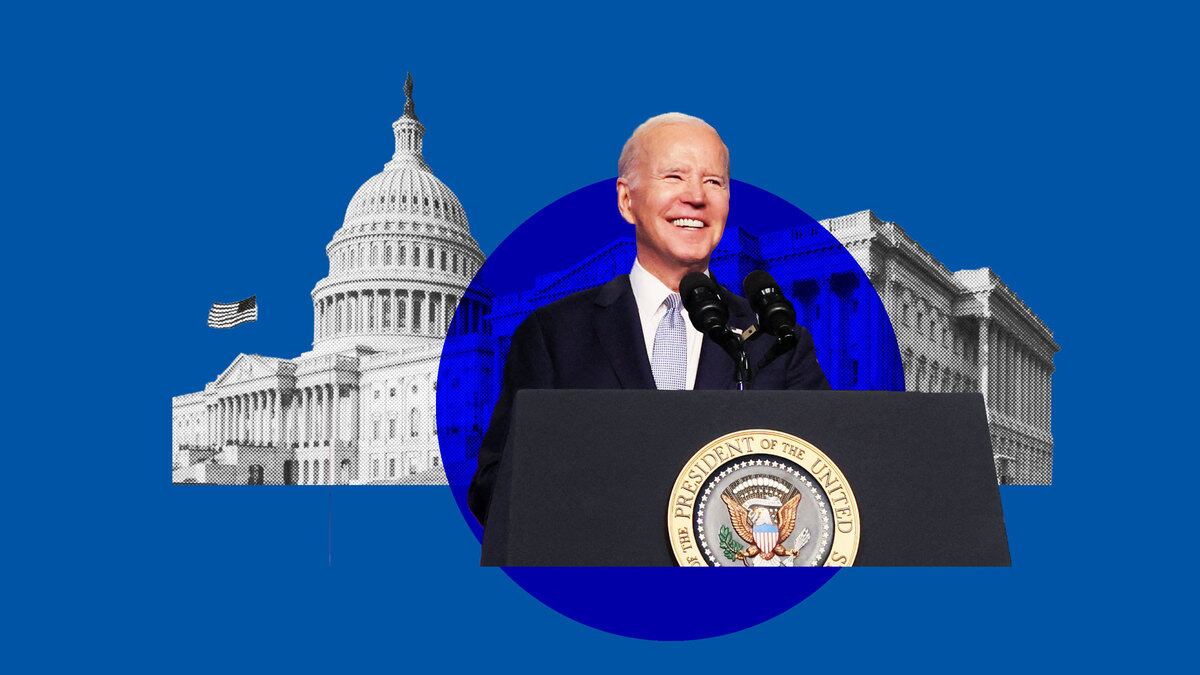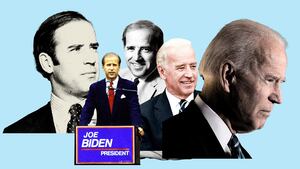A newly repaired bridge in western Pennsylvania. Brand-new permanent homes for unhoused people near Austin, Texas. Almost half a billion dollars for expanding high-speed internet access in California. A renewed $77 million K-12 summer program in Reno, Nevada. A million dollars in affordable housing in Eau Claire, Wisconsin.
These recent initiatives distill the nuts-and-bolts vision of progress that President Joe Biden is looking to sell during his re-election campaign, which he officially launched on Tuesday.
Biden likes to invoke the legislation that made projects like these happen: the sweeping clean energy-focused Inflation Reduction Act, the $1 trillion Infrastructure Investment and Jobs Act, the high-tech manufacturing-boosting CHIPS Act. Those three bills are poised to be pillars of Biden’s case for a second term. But there’s a fourth pillar that often seems forgotten—the one that made these specific projects, and many others, possible.

The American Rescue Plan, enacted in March 2021, was possibly Biden at his most ambitiously liberal—a Rooseveltian $2 trillion swing at dragging the country out of the health and economic carnage wrought by the pandemic. It was packed with social safety net expansions, like unemployment benefits and a child tax credit, along with hundreds of billions of dollars in grants for state and local governments that funded projects nationwide.
Into its third year of existence, the American Rescue Plan continues to have a surprisingly durable impact, at least going by the stream of news clips from different corners of the country that cite the legislation as the source of funding for local projects.
But for all the policy wins, the lofty legislation appears to be far less of a focal point for the party from a messaging perspective. Lawmakers and prominent officials have spent much more time touting recent bills like the Inflation Reduction Act and CHIPS Act.
The same might be said for Biden’s own campaign operation: in a graphic tweeted by a Biden campaign account on Tuesday, for instance, the ARP was not even mentioned on a list of over a dozen “Biden wins” from his first term.
The question of what legislative wins Democrats focus on is not an insignificant one.
Democrats have learned from the past that it’s much more effective to tout a limited list of your most important and popular victories—like a $35 insulin cap for Medicare recipients—rather than a laundry list of triumphs that make each achievement less memorable.
The president himself does name-check the ARP, often in the same breath as other key legislative wins. A White House spokesman sent The Daily Beast segments of three recent speeches in which Biden touted the bill. In one, he called it “the most aggressive economic recovery package since Franklin Roosevelt.”
There are various theories as to why the legislation, despite its continued impact, might be relatively overlooked.
For one, the ARP was tied to a politically fraught moment in time—the pandemic, which Democrats are eager to show voters they’ve left behind—and many of its programs were short-lived, designed to ease the pain people felt then.
Beyond that, Sen. Tim Kaine (D-VA) noted to The Daily Beast that the legislation passed on a party-line vote—unlike the infrastructure and CHIPS legislation, which Biden loves to mention to burnish his bipartisan bona fides.
But a bigger reason may be tied to the issue that is perhaps the sorest spot for Democrats: inflation. Last year, leading Democratic economic thinkers, like former Treasury Secretary and occasional Biden adviser Larry Summers, blamed the ARP’s injection of stimulus into the economy for the worsening inflation that dogged the party.
A Democratic source close to the White House, who requested anonymity to speak candidly, suggested to The Daily Beast that Bidenworld’s sensitivity to the inflation issue might have discouraged them from centering the ARP more in its messaging.
Even though the GOP’s response to Biden’s campaign launch was muted on Tuesday, several lawmakers and party organs centered inflation in their pushback, signaling the issue will remain a focus, even as inflation rates slowly ease from the heights of the last two years.
As Biden crafts his case for re-election, the question of how his biggest legislative project—one with a far-reaching scope and complicated legacy—fits into that case is an important one.
In his campaign launch video, Biden framed the upcoming election—one in which Republicans are likely to nominate former President Donald Trump—as a choice of freedoms, contrasting his stances with the GOP’s desire to curtail abortion rights and LGBTQ rights, among other things.
Yet Democrats seem eager to lean into Biden’s unusually full legislative résumé to argue that he fulfilled his promises and can achieve major policy wins.
“This can now be a show-and-not-tell,” said Jesse Ferguson, a longtime Democratic strategist, “because he has police departments that were funded, infrastructure projects that are rolling, and vaccines that are available, all because of the work he did.”
The ARP, some Democrats believe, could be utilized more to strengthen that message far more than it is right now—particularly because some of Biden’s other wins, like the IRA and infrastructure bill, may take longer to impact voters than the ARP already has.
“The technocrats in the building are like, ‘We can’t talk about the ARP because the [stimulus] checks are gone, the cash is gone, the child tax credit is gone,” the source close to the White House said. “They’re not getting the credit they could. I don’t think it’s too late. It’s very easy for them to reincorporate that into their campaign victory lap.”
Lawmakers and strategists insist the ARP will be a key part of their 2024 messaging. A Democratic aide, granted anonymity to candidly describe strategy, told The Daily Beast that the party would likely frame the legislation’s impacts as part of a broader Biden economic agenda.
“Whether it’s coming from the ARP, or the infrastructure bill, or the Inflation Reduction Act, they’re Joe Biden and Democratic-led initiatives,” said the aide. “Democrats are rightfully proud of the ARP; I don’t think anyone’s trying to run away from it. There’s just a ceiling of what you can talk about for voters.”
Kaine, for his part, said that voters don’t exactly care where the money comes from, just that important improvements in their communities are being funded.
“I was out announcing projects that were infrastructure bill projects, projects that were CHIPS projects, projects that were earmark projects… for some in the audience, those distinctions are meaningless,” he said. “But they do know we’ve worked hard and we’ve passed some bills and this is being done.”
But the factor that best explains the ARP’s continued impact is one that makes it harder for Biden and his political operation to take a victory lap.
Beyond the direct stimulus payments and unemployment benefits, the tens of billions in COVID mitigation, and $120 billion in school reopening funds, a wide swath of the ARP—$350 billion—was set aside for grants to state and local governments. Tens of billions of dollars more were allocated for grants to fund specific local projects, like affordable housing initiatives.
In the first year of the pandemic, states, counties, cities, and tribes were expected to face a fiscal crunch due to decreased revenue from income and sales taxes. The most dire predictions did not come to pass—and governments ended up with a surplus of funds for them to use as they saw fit.
Ironically, in doing so, governments ended up advancing Biden policy goals—on affordable housing, health care, and more—that Democrats failed to address on a broader level in subsequent bills, like the doomed Build Back Better Act.
In a particularly creative move, the city council of Cleveland, Ohio, voted to use $1.9 million in ARP funds to cancel the medical debt of 50,000 city residents.
This plank of the legislation has aged into one of its most controversial, with conservatives and some moderates arguing that the grants were far too generous and worsened the inflationary impacts of the bill. Now in control of the House, Republicans have proposed revoking unspent ARP aid as a way of balancing the budget.
But to some, the party could do a better job—from Biden on down—in taking credit for what state and local governments have done with ARP funds, which so frequently gel with their overall economic and social policy goals. Because the administration did not direct the projects themselves, they might be harder to publicize, but Democrats still say that credit-taking would be appropriate.
“They haven’t done a good job crowing about state and local projects,” said the source close to the White House.
Lily Roberts, who has tracked the ARP’s lifespan at the liberal Center for American Progress think tank, said even she was surprised at the legislation’s enduring impact.
She argued that many of the bill’s impacts were so catered to the pandemic that it’s difficult to tell voters now, “think about how much worse off you’d be if we didn’t offer a check, or extend the child tax credit.”
“I tend to think it’s important to take credit for those things and talk about them,” Roberts added. “There’s been an enormous payoff at the state and local level… Those programs will outlast anyone remembering what the ARP was.”








